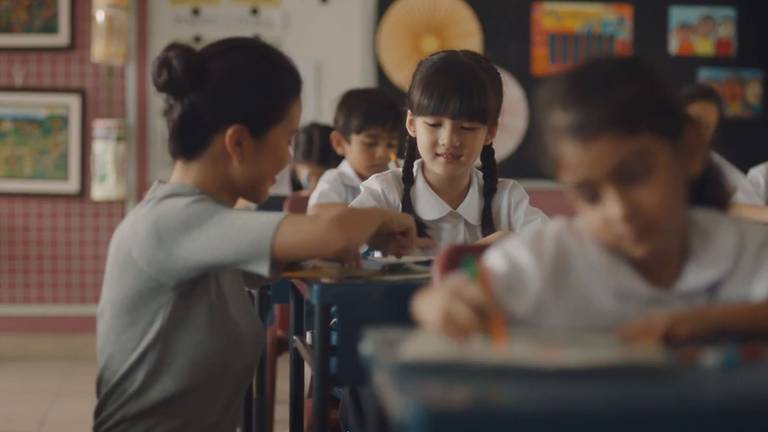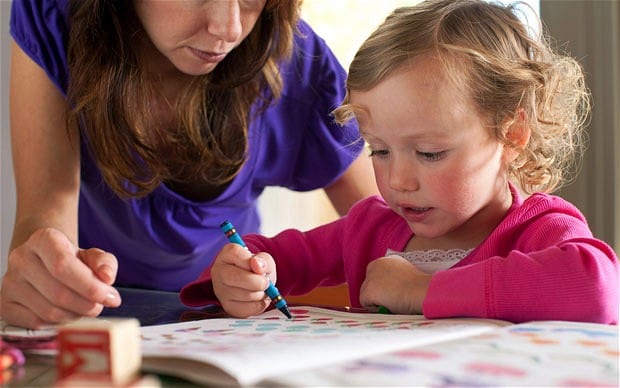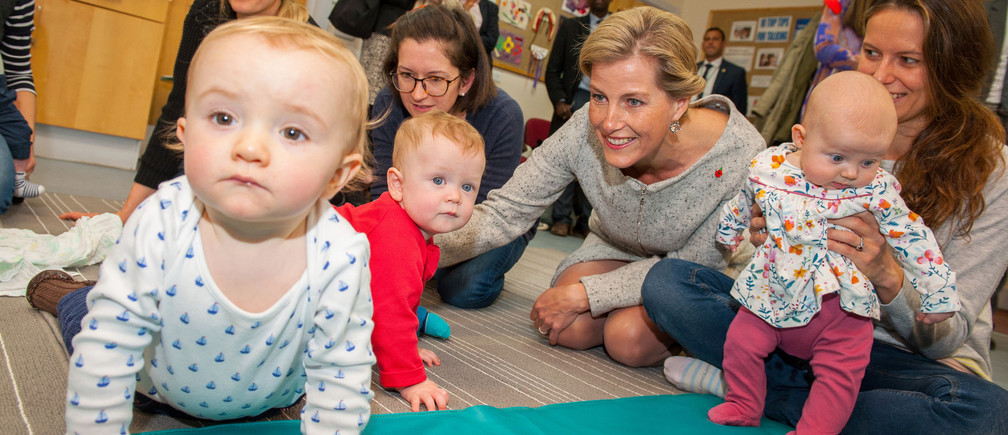-
What hope do monolingual parents have in raising bilingual children?
A series of videos promoting the use of mother tongues has recently been released by the Lee Kuan Yew Fund for Bilingualism.
These videos are intended to promote the use of mother tongues, stressing its importance in bridging connections with others and retaining a strong national identity.
The need for these videos may speak to some of the ambivalence and challenges families often face in raising bilingual children. Particularly in families where parents do not speak the mother tongue, they may feel overwhelmed and uncertain when it comes to figuring out how to raise a bilingual child.
Can parents who don’t speak their mother tongue raise children who do?
And can they do so without resorting to expensive tuition classes?
Thankfully, research tells us that parents who do not speak two languages can raise bilingual children who become fully proficient in both languages.
However, unlike bilingual families, these parents will be more dependent on outside sources, such as childcare facilities, community resources, schools or tutors, to provide second language exposure and instruction.
WHO’S TEACHING THE MOTHER TONGUE?
For monolingual families, well-designed and effectively implemented bilingual education programmes can provide an excellent and sustainable route to bilingualism.
Bilingual education programmes that maintain best practices in second language instruction should be sufficient to build up mother tongue proficiency without the need for supplementary tuition.
But what distinguishes good bilingual education?
The sheer amount of time that children hear a mother tongue predicts their eventual success. Children with longer exposure to the mother tongue go onto greater proficiency.
However, bilingual education is not just about clocking hours – it is also about how this time is being spent. In learning a mother tongue, it is good for children to have exposure and interaction with a variety of mother tongue speakers and for these interactions to be with fully proficient native speakers. Such speakers can provide the best language model for young learners.
So, the more the better, both in terms of time spent and the number of speakers encountered.
The success of mother tongue education relies on interaction with live partners. While many parents may be tempted to let the television playing cartoons or sitcoms in the mother tongue babysit children in the hope that kids will pick up the language with the passage of time, research shows children learn better from live interaction and conversation than passive media consumption.
The mode of instruction also matters, although some children draw more from spontaneous social opportunities whereas others draw more from more structured learning.
The reality is some children gravitate towards structured learning where they learn rules and word meanings, and armed with this knowledge, feel comfortable to engage in spontaneous conversation. Others much prefer spontaneous conversation and use these conversations to draw out rules and word meanings.
But crucial to both is a chance to interact and converse with a partner.
While mother tongue tuition can be helpful, a good bilingual education should suffice to build up native mother tongue proficiency.
Parents can also resort to social opportunities, such as interest groups via Meetup, or immerse themselves in cultural events at Community Centres to seek out opportunities for their children to use the mother tongue.
Parents can also actively support peer friendships and play opportunities with native speakers of a mother tongue. Children are typically less deterred by a language barrier with those they meet than adults and they are often very willing to enjoy play with another child with shared interests, even if they speak a different language.
Community and peer engagement will have to be a more active effort for monolingual families, but it is a worthy investment in their child’s bilingual journey.
ARE KIDS MOTIVATED TO MASTER THEIR MOTHER TONGUE?
Research shows us that motivation for second language learning in children is more important than language learning ability in reaching bilingual proficiency. A child who is highly motivated to learn their mother tongue will typically fare much better than one who is not.
As parents often recognise, creating and sustaining motivation for the mother tongue can present one of the biggest challenges to teaching children their mother tongue.
Many children, even toddlers, simply refuse to talk in a mother tongue choosing to speak English, even though they understand their mother tongue. This is a common scenario that reflects in the child both a language preference and a selective appreciation for the usefulness of one language over the other.
But this barrier must be overcome so that kids don’t stay passive bilinguals (children who understand two languages but only speak in one) but make progress to become active bilinguals.
The reality is that children cannot be pressured to interact in a mother tongue, nor can they be easily convinced of the logic of why learning an additional language is important.
Children are motivated to learn a language when they believe that the language is useful to them in their eyes. For example, many parents believe that learning Chinese is a strategic choice that will give their children opportunities in their future careers, yet this is not a line of reasoning that would readily appeal to a 5-year-old.
For this reason, good bilingual education programmes often have clever, creative ways to engage children in the host culture of a second language to enliven the experience of learning. For example, learning about interesting cultural practices or popular culture in the mother tongue can fuel a curiosity for the language in children.
While this is not directly teaching vocabulary or grammar, it is a crucial step towards building motivation than can bolster an uptake of vocabulary and grammar.
But if one language is actively used in a child’s life to converse in school, maintain friendships and family bonds, and access the ever-appealing world of entertainment while the other language is confined to textbooks and homework exercises, then both languages will start to mean different things.
The child may naturally gravitate towards the language that they actively use at the cost of the second language, limiting a child from realising their bilingual potential.
But a child who views their knowledge of a second language as a means towards forging important social bonds, pursuing their own hobbies or interests, or making valued cultural connections in their life will be more likely to persevere in the hard work of learning another language more than a child who sees a second language as just another examinable subject.
BILINGUALISM A FAMILY AFFAIR
Finally, as with all aspects of learning, children learn within the bounds of their own “ecosystem”. A child raised in a family environment where bilingualism is valued and prioritised by the parents – even if they are not providing bilingual input at home – is more likely to become bilingual than one whose family holds an indifferent view towards bilingualism.
Many monolingual parents often approach bilingualism in a direction that is less than ideal. Specifically, we teach word by word. In other words, we hope that children will learn words in a Mother tongue to be able to access the “world” of the Mother tongue. But it can be equally important for children to be drawn to the “world” of the mother tongue in a way that makes them want to learn the words.
Children inherit their parents’ attitudes in many respects, and bilingualism is no exception.
For monolingual and bilingual families alike, developing a sustainable and consistent family language policy where each member of the family agrees upon and actively supports bilingual acquisition can greatly benefit a child.
This can mean actively seeking to create opportunities for children to engage in their mother tongue by attending community events or by forging partnerships with peers and neighbours to encourage mother tongue use.
Family language policies vary greatly depending on the languages spoken by each member of the family and on what works best for an individual child. There is no one-size-fits-all solution for all children.
What is important is that children receive similar amounts of high-quality exposure and interaction opportunities for both languages and that children see the relevance and appeal of both languages in their lives.
Leher Singh is director for the National University of Singapore’s Infant and Child Language Centre and Associate Professor of Psychology.
Leher Singh
Source: CNA/sl
Read more at https://www.channelnewsasia.com/news/singapore/commentary-what-hope-do-monolingual-parents-have-in-raising-9842552LCF can help bilingual children
-
-
Children should start learning languages at age three’
Our European neighbours shame us by their ability to converse in English. The Government would like that to be a thing of the past. So would Catherine Ford
There are incredible psychological benefits of learning another language. These benefits extend way beyond being able to order a cup of tea abroad.
Longitudinal studies by Harvard University confirm that learning additional languages increases critical thinking skills, creativity and flexibility of the mind in young children.
Pupils who learn a foreign language outscore their non-foreign language learning peers in verbal and maths standardised tests, indicating that learning additional language is a cognitive activity not just a linguistic one.
The brain, like any muscle, functions better with exercise. Learning a language involves memorising rules and vocabulary, which helps strengthen that mental muscle.
When children join the preschool class of Moreton First at three years of age, they are exposed to four languages.
The rubrics of spoken English are practised and enhanced through songs, stories and nursery rhymes, and modelled and explored as the children enter their make believe world of role play.
French lessons are introduced and, without even realising they are learning a second language, the children follow the story book adventures of favourites such as ‘Bob le bricoleur’ and the ‘La Chenille qui a très faim’. Using the mediums of music and drama, the children can be heard spontaneously singing along to French songs.
‘Mr China’, nicknamed by the children, arrives in our pre-prep class with props and games and Mandarin Chinese begins. Ni hao! At the age of three and four, our youngest pupils engage in game-like activities and within a short time become familiar with the language that now dominates the international business world.
The preschool home corner is dotted with Spanish and English labels. The children have the opportunity to play there accompanied by a fluent Spanish teacher. As the children create imaginary games she models Spanish, encouraging the children to copy her. It is fun and learning is incidental.
However, further exciting research on the benefits of this early learning has come from Dr. Pascual-Leone, professor of medicine at Harvard Medical School.
His study provides an important first step in understanding the impact of learning a second language and the ageing brain. This research paves the way for future causal studies of bilingualism and cognitive decline prevention.
But why should learning another language be started at such a young age?
Simply, the younger the learner, the better they are at mimicking new sounds and adopting pronunciation. The brain is open to new sounds and patterns in preadolescence.
At this age, young children have time to learn through play-like activities. Language lessons can be informal and children’s minds are not yet cluttered with facts to be stored and tested. Before children become self- conscious they can try out their newly acquired languages without fear of embarrassment.
Children who grow up learning about languages develop empathy for others and a curiosity for different cultures and ideas; prepared to take their place in a global society. Furthermore, in later years, career opportunities increase for those with additional languages to offer.
As the academic year gets under way and most schools gear up to accommodate the Government’s directive for Autumn 2014 – that every seven year old child should have lessons in a foreign language – I ask: why wait until seven?
Catherine Ford, head teacher of Moreton First Prep School
Copy of : http://www.telegraph.co.uk/education/educationopinion/11151726/Children-should-start-learning-languages-at-age-three.html
-
-
Learning a second language can have benefits for our brain that go far beyond language itself. And when it comes to young children, research is continuing to show how picking up a second language can change the way they think and develop cognitive skills during a critically important time for brain development.
One recent study at the University of Oregon showed children aged four and younger who could speak two languages displayed greater inhibitory control than their monolingual counterparts. Inhibitory control is our ability to stop ourselves from reacting to a situation hastily and instead applying a more adaptive response.
Unsurprisingly, children who started off bilingual during the experiment started off with higher scores. But children who learned a second language by the end of the experiment showed rapid gains in inhibitory control compared to those who stayed monolingual.
“The development of inhibitory control occurs rapidly during the preschool years,” said study co-author, Atika Khurana, a professor at the University of Oregon. “Children with strong inhibitory control are better able to pay attention, follow instructions and take turns. This study shows one way in which environmental influences can impact the development of inhibitory control during younger years.”
For this study, researchers sampled 1,146 children and assessed their inhibitory control levels at the start of the experiment. They then followed the children for 18 months and scored them again based on their language ability: those who spoke only English; those who spoke both Spanish and English; and those who spoke only Spanish at the start of the study but were fluent in both English and Spanish at the end.
The test itself was comprised of a common task for assessing inhibitory control in youths. The participant is told to tap a pencil on a desk twice when the experimenter taps once, and vice-versa. This requires the student to suppress the immediate impulse to mimic the experimenter and do the opposite instead.
Students in this study came from low socioeconomic backgrounds – a group known to be at-risk for poorer outcomes. But the the study shows how bilingualism can help preschool children improve their cognitive function rapidly and gain valuable and lasting skills in executive decision-making.
In an interview with the Independent, author of “The Secret Life of the Mind: How Your Brain Thinks, Feels, and Decides” Marian Sigman explained just how learning a second language at a young age can have lasting effects for people throughout their lives:
“…The one thing we know is that bilinguals are much better in cognitive control than monolinguals. Many, many studies have found that cognitive control is one of the most decisive variables, one of the most important pieces of cognitive function. People that have good cognitive control do good at school, typically find better jobs, are healthier. They have better social insertion.”
Copy from : http://fanvive.com/2017/11/17/learning-second-language-as-a-young-child-has-huge-benefits-for-the-brain/
-
-
 I-LABS researchers have found that it is possible to give very young children the opportunity to start learning a second language.Image: REUTERS/Dominic LipinskiThis article is a copy of what was published in Futurity on 24 Jul 2017Researchers have developed a play-based educational program that can teach babies a second language in just one hour per day.
I-LABS researchers have found that it is possible to give very young children the opportunity to start learning a second language.Image: REUTERS/Dominic LipinskiThis article is a copy of what was published in Futurity on 24 Jul 2017Researchers have developed a play-based educational program that can teach babies a second language in just one hour per day.For years, scientists and parents alike have touted the benefits of introducing babies to two languages: Bilingual experience has been shown to improve cognitive abilities, especially problem-solving.
And for infants raised in households where two languages are spoken, that bilingual learning happens almost effortlessly. But how can babies in monolingual households develop such skills?
“As researchers studying early language development, we often hear from parents who are eager to provide their child with an opportunity to learn another language, but can’t afford a nanny from a foreign country and don’t speak a foreign language themselves,” says Naja Ferjan Ramirez, a research scientist at the University of Washington Institute of Learning & Brain Sciences (I-LABS).
A new study by I-LABS researchers, which appears in the journal Mind, Brain, and Education, is among the first to investigate how babies can learn a second language outside of the home.
The researchers sought to answer a fundamental question: Can babies be taught a second language if they don’t get foreign language exposure at home, and if so, what kind of foreign language exposure, and how much, is needed to spark that learning?
The researchers took their query all the way to Europe, developing a play-based, intensive, English-language method and curriculum and implementing it in four public infant-education centers in Madrid, Spain.
Teaching with ‘parentese’
Sixteen undergraduates and recent graduates served as tutors for the study, undergoing two weeks of training at I-LABS to learn the teaching method and curriculum before traveling to Spain. The country’s extensive public education system enabled the researchers to enroll 280 infants and children from families of varying income levels.
Based on years of I-LABS research on infant brain and language development, the method emphasizes social interaction, play, and high quality and quantity of language from the teachers. The approach uses “infant-directed speech”—often called “parentese”—the speech style parents use to talk to their babies, which has simpler grammar, higher and exaggerated pitch, and drawn-out vowels.
“Our research shows that parentese helps babies learn language,” Ferjan Ramirez says.
Babies aged 7 to 33.5 months were given one hour of English sessions a day for 18 weeks, while a control group received the Madrid schools’ standard bilingual program. Both groups of children were tested in Spanish and English at the start and end of the 18 weeks.
Have you read?
“Science indicates that babies’ brains are the best learning machines ever created…”
The children also wore special vests outfitted with lightweight recorders that recorded their English learning. The recordings were analyzed to determine how many English words and phrases each child spoke.
The children who received the new method showed rapid increases in English comprehension and production, and significantly outperformed the control group peers at all ages on all tests of English.
By the end of the 18-week program, the children in the researchers’ program produced an average of 74 English words or phrases per child, per hour; children in the control group produced 13 English words or phrases per child, per hour.
Ferjan Ramirez says the findings show that even babies from monolingual homes can develop bilingual abilities at this early age.
“With the right science-based approach that combines the features known to grow children’s language, it is possible to give very young children the opportunity to start learning a second language, with only one hour of play per day in an early education setting,” she says. “This has big implications for how we think about foreign-language learning.”
‘The best learning machines’
Follow-up testing 18 weeks later showed the children had retained what they learned. The English gains were similar between children attending the two schools serving predominantly low-income neighborhoods and the two serving mid-income areas, suggesting that wealth was not a significant factor in the infants’ ability to learn a foreign language.
Children’s native language (Spanish) continued to grow as they were learning English, and was not negatively affected by introducing a second language.
 Image: South China Morning Post
Image: South China Morning Post“Science indicates that babies’ brains are the best learning machines ever created, and that infants’ learning is time-sensitive. Their brains will never be better at learning a second language than they are between 0 and 3 years of age,” says coauthor Patricia Kuhl, codirector of I-LABS and a professor of speech and hearing sciences.
The results, Kuhl says, have the potential to transform how early language instruction is approached in the United States and worldwide:
“Parents in Madrid, in the United States, and around the world are eager to provide their children with an opportunity to learn a foreign language early. The US census shows that 27 percent of America’s children under the age of 6 are now learning a language other than English at home.
“While these children are fully capable of learning both their parents’ language and English, they often do not have adequate exposure to English prior to kindergarten entry and as a result, often lag behind their peers once they enter school,” she says.
“I-LABS’ new work shows we can create an early bilingual learning environment for dual-language learners in an educational setting, and in one hour per day, infants can ignite the learning of a second language earlier and much easier than we previously thought. This is doable for everybody,” Kuhl says.
-
-
Fun Base Learning is one of the best methodology for teaching languages. It is best for learning and delivers amassing results. Fun Base Learning is suitable for children aged between 5 and 12 years and in primary schools, as well as those aged 0-5 years and in childcare centers.
The idea behind Fun Base Language Learning is making learning a fun-filled activity for all children. The little ones learn better when their lessons are filled with plenty of fun. This way, it is easier for their minds to retain new learning.
Languages Taught
Fun Base Learning approach has proved highly effective at teaching the following languages at LCF Fun Languages Australia:
- French
- Spanish
- Mandarin
- Italian
- German
More importantly, the classes at LCF Fun Languages Australia do not revolve around languages alone. On their own, languages may not be fun to learn. The methodology used in making languages fun to learn features several activities that include games, technology, dance, music and songs, activity sheets, drama and role playing.
Small Group Learning
Each teacher takes care of a small group of learners. This ensures that all students receive the personal attention required to learn a new language successfully. The approach works well regardless of the student’s familiarity (or lack thereof) with the new language.
The methodology takes cognizant of the natural process that is involved in acquiring or learning a new language, especially among little children. This method trains children to excel in not only listening, but also repeating, speaking, reading and writing the newly acquired language.
Encourages Independent Learning
The fun-based approach allows children to develop into independent learners. It directs them towards learning by making inquiries too. The fact that children naturally love to explore and possess highly inquisitive minds helps make the entire approach quite successful.
Children who show up for the fun-based learning may already have a first language. The program uses this as the basis for teaching them a second language. It does not ignore the similarities and differences that exist between the children’s first and second languages.
The driving guide of the entire program is communication. This is closely related to inter-cultural understanding that the program endeavors to transmit to the young minds. At the end of the program, each student becomes a good communicator and understands other cultures well.
Therefore, the premise is that Fun Base Language Learning is not only best for learning, but also the perfect approach for delivering great results. It benefits children in several ways by allowing them to learn in fun-filled surroundings.
Contact us to start a language program at your primary school or childcare centre. www.lcfclubs.com.au or 1300 707 288
LCF Fun Languages Australia Media Team
(*LCF Fun Languages Australia, operates pre-school, childcare centre, kinder, Montessori, before and after-school language learning centres across Australia. Operating throughout Europe, Australasia, South America and Asia, LCF started teaching languages in 1985 with a method based on the natural way that children acquire a language.)
-









